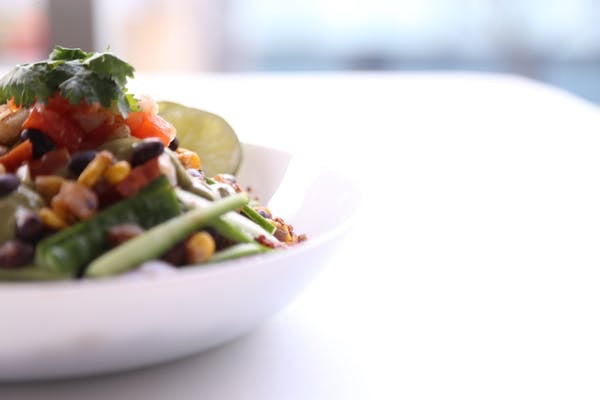
In an article first published on The Conversation, YASMINE PROBST, ELIZABETH NEALE and VIVIENNE GUAN, all of the University of Wollongong, look at how food choices can help with losing weight…
It’s difficult to lose weight. And it’s even harder to keep it off. Many people achieve short-term weight-loss only to return to their previous lifestyle choices – and their previous weight – over time. This can lead to yo-yoing between weight loss and weight gain.
One of the problems is that weight-loss diets aren’t sustainable. They leave dieters feeling hungry and aren’t giving them the essential nutrients they need to maintain their long-term health.
But certain food choices can promote weight loss and provide the nutrients you need to function well and thrive. These four food choices are a good place to start.

Vegetables contain essential nutrients including potassium, folate and fibre. PICTURE: Hermes Rivera
“[C]ertain food choices can promote weight loss and provide the nutrients you need to function well and thrive. These four food choices are a good place to start.”
1. Whole grains help us to feel full
Many of us choose bread as part of our lunchtime meal. Switching from white to whole grain bread for your sandwich can help you feel full for longer, so you’re likely to eat less during the following meal.
The whole grain is made up of three major parts: the bran, endosperm and germ. This structure helps some of the energy to escape during the digestive process, leading to the body absorbing fewer kilojoules.
Whole grains help protect against chronic diseases including heart disease, type 2 diabetes and some cancers. The grains exert their benefits by regulating bowel function through increased faecal bulk and by feeding healthy gut bacteria.
Whole grains are easy to include in a weight-loss diet. In addition to breads, they can also be found in oats for breakfast, or popcorn for a snack.
2. Colourful veggies provide a range of nutrients
Vegetables are full of essential nutrients including folate, vitamin C, various B vitamins, potassium and fibre. They are also low in energy, providing approximately 100 to 350 kilojoules per 100g (24-84 calories per 100g).
When trying to lose weight, people tend to eat greater quantities of vegetables, but they don’t tend to choose a wide variety of vegetables beyond those they normally eat.
To aid weight loss, make sure you’re getting a high proportion of your kilojoules from vegetables and try to have as many different colours on your plate as you can.
If you feel like you don’t have time to cook, frozen vegetables are a quick and easy option, and they are just as nutritious as fresh vegetables.
3. Snack on nuts
When trying to lose weight, high-fat foods are often the first to go. But while nuts are generally high in fat and related kilojoules, they are high in fibre, helping us to feel full for longer
Nuts contain a number of beneficial vitamins and minerals for our health including healthy fats, protein, various B vitamins, zinc, magnesium and other minerals. Eating nuts has been shown to be beneficial in reducing the risk of heart disease and managing type 2 diabetes.
We’re also beginning to realise we don’t absorb all the kilojoules from nuts when we eat them. In fact, research suggests we absorb up to 30 per cent less fat from nuts than we had first thought.
Try eating a handful of nuts (around 30 grams) as a snack or adding them to your meals throughout the day.
4. Quench your thirst with water
Listening to your hunger and thirst signals can make a big difference when trying to lose weight.
Throughout the day, our bodily signals for thirst may be greater than our feelings of hunger. When you think you’re hungry, see if you are actually thirsty by having a glass of water first.
If you’re used to reaching for soft drink or cordial rather than the water, start the switch slowly. Replace half of each glass you drink with water and increase the water component over time. Eventually your preferences will shift.
Our bodies need water for fluid balance, body temperature regulation, cognitive performance, as well as gastrointestinal, kidney and heart function. Drinking plenty of water also improves the complexion of the skin and can reduce the likelihood of getting headaches.
A final word
Although some food choices can promote weight loss and prevent subsequent weight gain, your total eating pattern is the ultimate predictor of body weight. Exercise and physical activity also plays an important role.
A healthy eating pattern for weight loss should be based on the Australian dietary guidelines, which are general recommendations for healthy eating. Aim for five serves of vegetables and two serves of fruit a day, alongside whole grain breads and cereals, lean meat and low-fat dairy. While this may sound like a lot of food, studies have shown these combinations will aid weight loss.
Although there will always be easier ways of losing weight, small changes towards healthier eating habits will help you to not only lose weight, but will provide you with the right habits to avoid regaining weight in the future.![]()
Yasmine Probst is a senior lecturer in the School of Medicine at the University of Wollongong; Elizabeth Neale is a career development fellow (lecturer) at the University of Wollongong, and Vivienne Guan, is associate research fellow at the University of Wollongong. This article is republished from The Conversation under a Creative Commons license. Read the original article.





